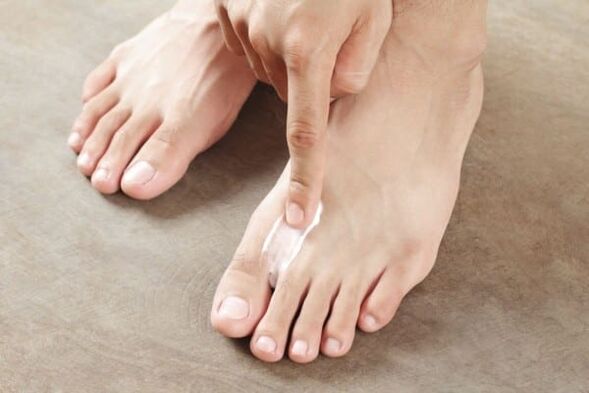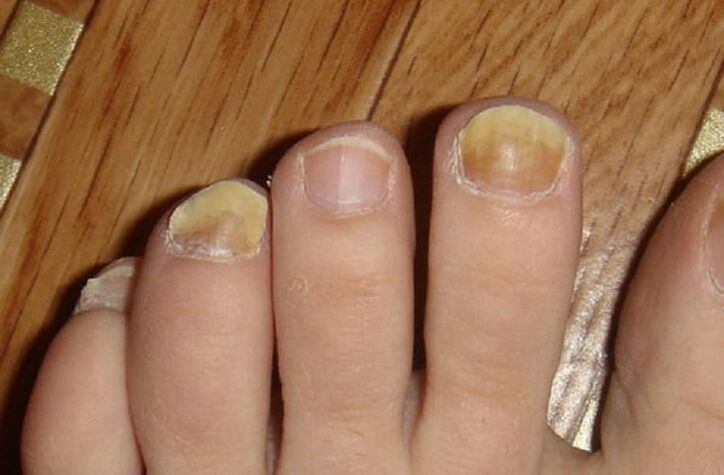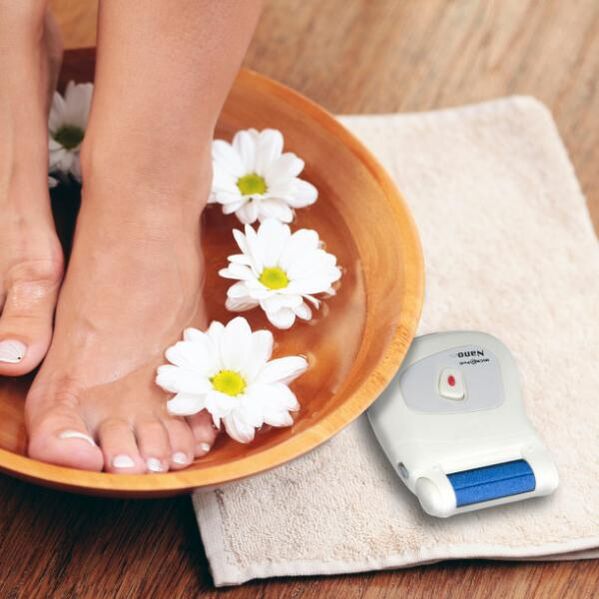The fungus that appears on the skin of the feet is one of the most common infections. The fungus on the legs is characterized by vitality and easy development. If you rely on statistics, 20% of the world’s population suffers from the fungus.

What is a skin mushroom?
Fungal diseases are infectious diseases that affect the skin. The most common type of fungus is mycosis. In medicine, this skin disease is divided into several types.
The fungus is able to adapt to almost any habitat condition. Mushroom spores can live in casual clothes or shoes for long periods of time. In most cases, fungal infections affect a person's feet and nail plates.
How does mycosis work?
The pathogens of foot mycosis are Trichophyton rubrum, T. Mentagrophytes and Epidermophyton floccosum. Mycosis can be contracted by contact with infected skin or the use of any personal care product.
Mycosis is characterized by the destruction of the skin in the form of exfoliation. This is due to the fact that the fungus penetrates deep under the skin, causing damage to the epidermis.
Yellow or white spots may appear on the nails. If the fungus touches the toes, small bubbles form with liquid between them, which explode, healing is painful. The fungus is also accompanied by an unpleasant odor. The symptoms of mycosis can vary depending on the type. To do this, you need to get to know each of them in more detail.
The main forms of mycosis are:
- Interdigital mycosis.
- Squamous hyperkeratotic form.
- Blistering shape.
- Deleted form.
- Nail fungus.
Interdigital mycosis
The most common localization of the interdigital fungus is the distance between 3, 4, and 5 toes.
The main symptoms of interdigital mycosis are:
- The formation of a crack covered with a thick film of white fluff.
- A small amount of liquid may be released from the crack.
- Appearance of diaper rash between the toes.
- Slight itching between the fingers.
Initially, the fungus between the toes may be dormant without symptoms. However, the changes can be observed gradually - the skin becomes dry and rough, it gets a grayish tint, cracks appear in rough places.
In addition, there is a so-called "wet" fungus between the fingers. This form is characterized by the formation of bubbles filled with liquid. These bubbles burst, creating the effect of a "wet" fungus. Such fungus most often develops after wearing tight, non-ventilated shoes and during severe stress.
Squamous hyperkeratotic form
The squamous-hyperkeratotic form of mycosis is characterized by severe exfoliation and keratinization of the skin. This form of mycosis is very common, but most commonly affects people with atopic dermatitis.
The main symptoms of squamous cell hyperkeratotic form of mycosis are:
- Slight itching.
- Formation of cracks in the skin of the foot.
- Pain.
- Dry skin.
- Exfoliation of the skin.
- Erythema with clear boundaries.
- Yellow scales.
- Onychomycosis - damage to the nail plates.
Blistering shape
The vesicular form of the fungus is the rarest. Only 8% of patients with mycosis are exposed to this type of disease. The blistering form is characterized by the formation of rashes with a liquid content inside. When these blisters explode, erosions appear that can become infected.
The main symptoms of the blistering fungus are:
- Formation of red or pink blisters.
- There is a clear colored liquid inside the formations.
- The blisters can be up to 1 cm in diameter.
- The rash may be accompanied by a slight itching.
- Wet blisters.
This form of mycosis is dangerous because there is a high chance that harmful bacteria and infections will get under the skin. Special tests should be performed to determine the blistering form of mycosis, and skin scraping should be performed for analysis, as this disease can be easily confused with external symptoms with eczema or pustular psoriasis.
Deleted form
The deleted form of the fungus is almost always the beginning of the development of foot diseases - mycoses.
With the deleted form of the fungus, there are virtually no visible symptoms, but some of them can still be distinguished:
- There is a slight peeling skin between the toes.
- The formation of small cracks between the fingers that affect only the upper layers of the epidermis.
All these symptoms are not accompanied by itching or pain and therefore do not cause any discomfort to the person.
Nail fungus
Nail fungus is also a very common form of this disease. Such a mushroom does not pose a particular danger to human health, but it can cause many inconveniences.
Symptoms of nail fungus:
- Appearance of dryness and peeling of the skin of the foot.
- Itchy.
- Redness.
- Changing the shape of the nail.
- The color of the nails gets a grayish-yellow hue.
- Cracking of the nail plate.
- The fragility of the nail.
- Formation of a crumbling mass under the nail.
- Formation of voids under the nail plate.
- Bad smell.
When the leg fungus becomes severe, the patient's temperature begins to rise. Foot fungus, like all forms of mycosis, can cause the development of psoriasis or eczema.
What does a skin fungus look like on the leg?
Although foot fungus is a very common disease these days, not everyone knows exactly what it looks like. Many infected people do not even attach much importance to the appearance of the first signs of a fungal infection. As mentioned earlier, there are several types of fungi.
Each type has its own symptoms:
- In the initial stages of the infection, redness, mild swelling and cracks appear on the skin.
- In the middle stage of fungal development, peeling of the skin appears. The foot is covered with white, pink or white spots.
- Once the disease has developed to the highest degree, the nail plates on the toes collapse and change their normal color. The skin of the foot begins to peel off in large chunks. Deep and painful cracks appear.
Photo

Symptoms of foot fungus
To determine the fungus on the legs, attention should be given to the basic symptoms:
- Redness of the affected areas of the skin.
- Exfoliation of the skin.
- Formation of blisters with liquid content.
- Nails change color and shape.
- Fragility and delamination of nail plate.
Diagnostics
When showing the first symptoms of the fungus, consult a dermatologist. Sometimes a visual examination is not enough to make an accurate diagnosis.
Some symptoms may indicate the presence of other skin conditions. Therefore, in such cases, a specialist should scratch and perform a microscopic examination. Only after such studies can we speak clearly about the presence and form of the fungal disease.
Treatment
Treatment for a fungal disease should only be started after a full diagnosis has been made by a specialist who will need to prescribe various medicines to treat the disease. There are several ways to treat fungi on your feet.
These methods are:
- systemic therapy.
- local therapy.
- Folk remedies.
It is worth taking a closer look at each one.
Systemic therapy
Systemic therapy involves the use of various antifungal agents. Such drugs penetrate the bloodstream and kill the fungal infection. Such foundations are able to penetrate the nail platinum, which can persist for several weeks, gradually destroying the fungus.
Effective treatments for foot fungus
Terbinafine and itraconazole are effective antifungal agents. These systemic medications heal the patient in two weeks.
It is important to note that systemic therapy should not be prescribed to:
- Pregnant women.
- Breastfeeding mothers.
- Patients with liver disease.
- Elderly people with comorbidities.
Ointments and creams
It is recommended that systemic treatment of fungal diseases be combined with topical therapy. This method of treatment includes various creams and ointments, which can also have a fungicidal effect. However, it is worth paying attention to the fact that if the creams and ointments are used without systemic drugs, the treatment may be ineffective.
Topical drugs to combat fungal infections are divided into 20 forms. In addition to creams and ointments, various sprays, gels, foams and varnishes are used to treat foot fungus.
When applying topical treatment of the fungus, it is worth noting that after applying any treatment on the skin, the feet do not need to be washed during the day.
Folk remedies

You can also heal the fungus on your skin with the help of folk remedies. To do this, you need to get to know them in more detail.
Folk remedies for the treatment of nail fungus:
- At night, a piece of kombucha is applied to the affected nails.
- Attach a cut Kalanchoe leaf to your nails overnight.
Folk remedies for the treatment of fungi between the toes:
- Wash skin between fingers and apply patch.
- Make a decoction of plantain, yarrow, wormwood and chamomile. We make foot baths from the prepared broth.
Folk remedies for the treatment of foot fungus:
- Apply onion to the affected areas of the skin at night.
- Make a compress overnight from 20% propolis tincture.
Folk remedies for the treatment of foot fungus:
- Take a sea salt foot bath twice a day.
- Take a foot bath three times a day with a decoction of chamomile, oak bark and marigold.
Prevention
The fungus on the skin of the feet most often causes sweating. Even in the cold season, the pathogen of a fungal disease is well preserved. However, high temperatures can destroy the infection, so boiling is one way to prevent it. Another way to prevent this is to disinfect your shoes with formalin. With this operation, the fungus dies after 20 minutes.
Conclusion
In summary, it is worth noting that fungal disease of the skin of the feet does not harm human health. The fungus only causes discomfort. However, this infection should not be ignored. If the disease becomes severe, it can lead to pain and other infections.






























